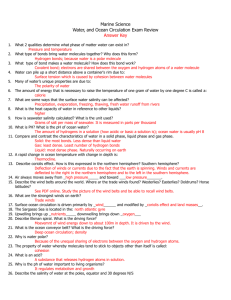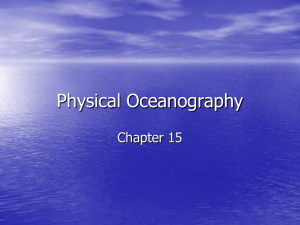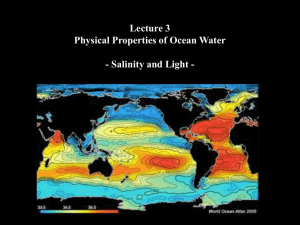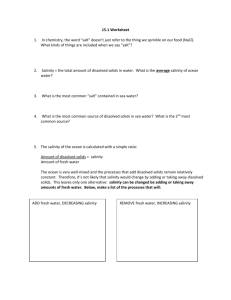Assignment #6
advertisement
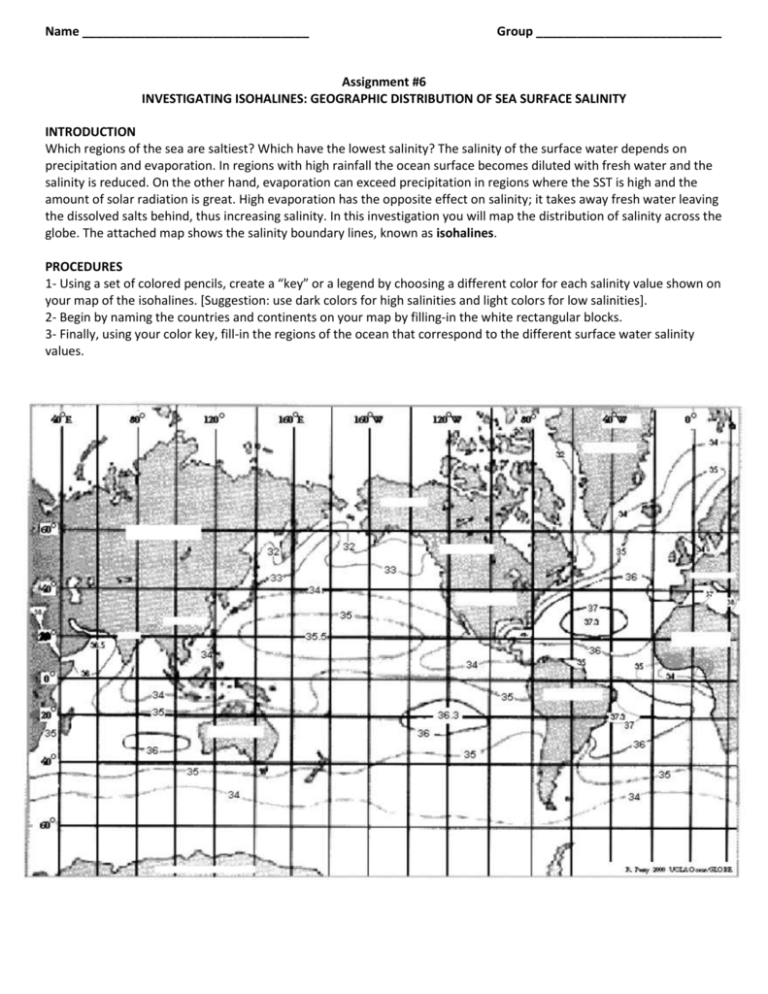
Name _________________________________ Group ___________________________ Assignment #6 INVESTIGATING ISOHALINES: GEOGRAPHIC DISTRIBUTION OF SEA SURFACE SALINITY INTRODUCTION Which regions of the sea are saltiest? Which have the lowest salinity? The salinity of the surface water depends on precipitation and evaporation. In regions with high rainfall the ocean surface becomes diluted with fresh water and the salinity is reduced. On the other hand, evaporation can exceed precipitation in regions where the SST is high and the amount of solar radiation is great. High evaporation has the opposite effect on salinity; it takes away fresh water leaving the dissolved salts behind, thus increasing salinity. In this investigation you will map the distribution of salinity across the globe. The attached map shows the salinity boundary lines, known as isohalines. PROCEDURES 1- Using a set of colored pencils, create a “key” or a legend by choosing a different color for each salinity value shown on your map of the isohalines. [Suggestion: use dark colors for high salinities and light colors for low salinities]. 2- Begin by naming the countries and continents on your map by filling-in the white rectangular blocks. 3- Finally, using your color key, fill-in the regions of the ocean that correspond to the different surface water salinity values. ANALYSIS OF DATA A. List the ocean regions that have the highest sea surface salinity. (You should list 7 regions; use the name of the ocean or the sea and the approximate latitude line to describe each region’s location.) B. List the ocean regions that have the lowest sea surface salinity. (List 4 regions) C. Describe the distribution of sea surface salinity patterns as a function of latitude. D. After studying a map showing the prevailing ocean surface currents (see Figure 9-12 in your text), describe the distribution of sea surface salinity patterns as a function of surface currents. E. List as many reasons as you can think of to explain why places like the Red Sea and the Mediterranean Sea have such high surface salinities. F. Give the concentration of seawater with a salinity of 3.45 percent in the following units: Hint: Since percent is ‘number of parts per one hundred’, to convert from percent to parts per thousand you multiply by 10. To convert from percent to parts per million you multiply by 10000. Since there are 1000 grams in a kilogram, it’s the same as parts per thousand. Same goes for kilograms per metric ton. a. b. c. d. ___________________ ___________________ ___________________ ___________________ parts per thousand parts per million grams per kilogram kilograms per metric ton G. Dittmar's Principle states that the major constituents of seawater exist in virtually a constant ratio to each other. Because chloride is the most common dissolved ion and one of the easiest to determine precisely, its concentration is determined, usually by a procedure known as the Knudsen titration, and from that measurement the salinity is calculated using the following formula: Salinity (ppt) = 1.80655 X chlorinity (ppt) What is the salinity of seawater with a chlorinity of 19.10 ppt? H. Recall that residence time, R, is the mean length of time a given element remains in the ocean. It is equal to the total amount of substance, C, divided by the rate of influx or addition, A (that is, R = C/A). The following table gives the total amounts of water, salt and sodium in the oceans, and the totals contributed each year by the river. OCEANS (initial amount) RIVERS (influx) Water 1.4 x 1018 tons 26.4 x 1012 tons per year Dissolved Salt 5 x 1016 tons 2.7 x 109 tons per year Sodium 14 x 1015 tons 15 x 107 tons per year Using the figures in the table, give the residence time for each of the following: Water Dissolved salt – Sodium - I. If the concentration of chloride in a seawater sample is 17.60 g/kg, what is the concentration of each of the following in g/kg? (You will need to refer to Table 6.1 in your text for this question; or look at the example on the next page) a. Sulfate ________________ b. Magnesium ________________ c. Calcium ________________ d. Potassium ________________ e. Sodium ________________ Example: Determining the Concentration of Major Ions in a Seawater Sample - First, you must have the knowledge of the typical concentrations of ions in seawater. This information can be obtained from a reference guide like the following table: - Next, you must know the concentration of one ion in your particular seawater sample: For example, if we took a water sample while in the Gulf Stream and measured the Sodium ion content to be 8.75 g/kg. - With this information, you can determine the amount of the other major ions because the RATIO of ions will remain constant in any sample of open ocean water. This means you will need to set up a ratio between the unknown ion and any known ion: For example, if you want to know the concentration of the Chloride ion, you will need to know the typical ratio between Chloride (the unknown ion in my sample) and Sodium (the known ion in my sample). - You can determine the RATIO from the table: 19.353 (chloride) : 10.76 (sodium) = 19.353 ÷ 10.76 = 1.795 - You can now use this ratio in the following equation: Unknown ion concentration = [Known ion concentration] × [RATIO of Unknown ion to Known ion] Cl - = [Na+ concentration] ÷ [RATIO of Cl -:Na+] Cl - = 8.75 g/kg ÷ 1.795 = 4.87 g/kg You must calculate a new ratio for each ion concentration that you wish to determine!





